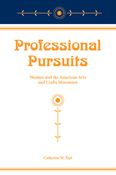Professional Pursuits
Women and the American Arts and Crafts Movement

- Author(s): Zipf, Catherine W.
- Series:
- Imprint: Univ Tennessee Press
- Publication Date: 2009-05-22
- Status: Active
- Available in Paper: Price $28.00 | Buy Now
- Leaf eReader required for PDF ebooks
The Victorian era provided few opportunities for women in the professional world. The American Arts and Crafts movement, which began in the late nineteenth century to promote handcraftsmanship over mass production, was a major factor in changing the status of women as professional workers. In Professional Pursuits, Catherine Zipf examines the participation of women in this significant design movement and the role they played in revolutionizing the position of women in the professional world. She also shows how, in turn, the Arts and Crafts movement set the stage for social and political change in future years.
Zipf focuses on five gifted women in various parts of the country. In San Diego, Hazel Wood Waterman parlayed her Arts and Crafts training into a career in architecture. Cincinnati’s Mary Louise McLaughlin expanded on her interest in Arts and Crafts pottery by inventing new ceramic technology.
New York’s Candace Wheeler established four businesses that used Arts and Crafts production to help other women earn a living. In Syracuse, both Adelaide Alsop Robineau and Irene Sargent were responsible for disseminating Arts and Crafts-related information through the movement’s publications. Each woman’s story is different, but each played an important part in the creation of professional opportunities for women in a male-dominated society.
Professional Pursuits will be of interest to scholars and students of material culture and of the Arts and Crafts movement. More importantly, it chronicles a very significant, little-understood aspect of the development of Victorian capitalism: the integration of women into the professional workforce.
Catherine Zipf is an assistant professor in the Department of Cultural and Historic Preservation at Salve Regina University. She has published articles in Women’s Art News and the Journal of the Society of Architectural Historians.
